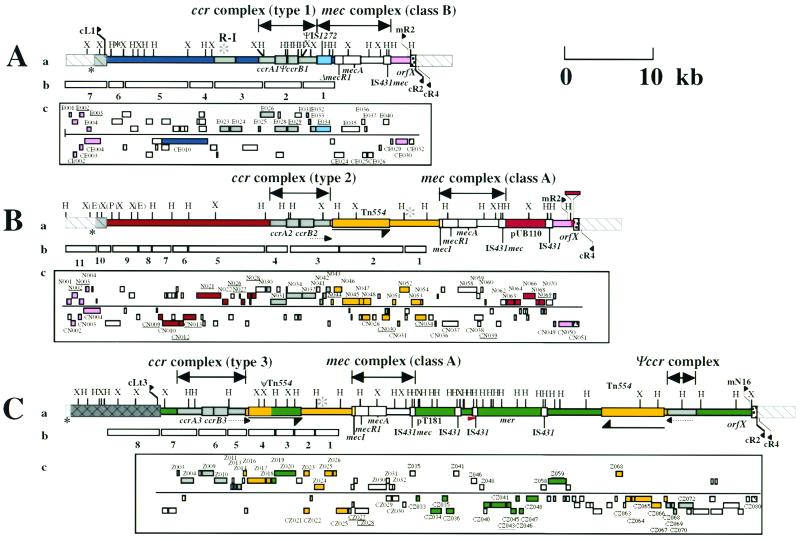FIG. 1.
Structures of three types of SCCmec. The structures of type I SCCmec (A), type II SCCmec (B), and type III SCCmec (C) are illustrated based on the nucleotide sequences deposited in the DDBJ/EMBL/GenBank databases under accession no. AB033763 (type I), D86934 (type II), and AB037681 (type III). (a) Essential structure of SCCmec. Locations of the essential genes are illustrated. The restriction sites of HindIII and XbaI are indicated. Only the EcoRI (E) and PstI (P) restriction sites, which are inevitable for the description of probes of type II SCCmec, are indicated (in parentheses). The essential genes as well as other regions are colored based on the color of the ORFs described in panel C. The regions common to MSSA are shown in white with gray-striped bars. The regions found in S. aureus NCTC 8325 and not found in ATCC 25923 are shown in gray with striped bars. The regions common to S. aureus ATCC 25923 and not found in NCTC 8325 are shown in dark gray with cross-hatched bars. Small black asterisks signify the locus common to all three strains. Large gray asterisks signify the region common to three SCCmecs. An arrowhead signifies the location of a 15-bp sequence similar to that of N315 found between the second and the third IS431 copies of type III SCCmec. Arrows indicate the direction of Tn554 or ΨTn554. Dotted arrows indicate the transcription of direction of the ORFs located downstream of ccrB or CZ072. (b) Probes used for dot-blot hybridization. (c) ORFs in and around SCCmec. The ORFs >200 bases in size in six possible reading frames are indicated by squares. Those above the line are the ORFs that have transcription directed to the right, and those below the line have transcription directed to the left. Colored squares are the ORFs the extant gene homologues of which were found in the databases, although many of them were considered incomplete (underlined). The color corresponds to the difference in the conservation of the ORFs (or regions) in three types of SCCmec white, ORFs in three types of SCCmec with identity of more than 99%: gray, conserved in three types of SCCmec with on identity score of 47 to 92%; magenta, ORFs common to type II and type III SCCmec; yellow, ORFs common to type II and type III SCCmec; blue, ORFs unique in type I SCCmec; red, ORFs unique in type II SCCmec; green, ORFs unique in type III SCCmec. ORFX is indicated in a stippled box.

